
Life in Color: Green. By National Geographic








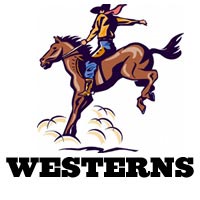 | FILMS Part 4 |
Early Television Westerns Shows: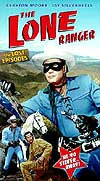 When television took its toll on western screen entertainment in the late 50s, the B-pictures transferred themselves to the small screen throughout much of the 50s and into the 60s. The Golden Age of the B Western, with low-budget, B-picture horse operas, was coming to an end. The TV Western resembled the second film features in theatre palaces in the 1930s and 1940s, with shows such as: When television took its toll on western screen entertainment in the late 50s, the B-pictures transferred themselves to the small screen throughout much of the 50s and into the 60s. The Golden Age of the B Western, with low-budget, B-picture horse operas, was coming to an end. The TV Western resembled the second film features in theatre palaces in the 1930s and 1940s, with shows such as:
More Classic Westerns:  More excellent adult westerns of the late 1940s and 1950s with classic character studies include William Wellman's The Ox-Bow Incident (1943) with Henry Fonda, and John Huston's adventure tale of greed More excellent adult westerns of the late 1940s and 1950s with classic character studies include William Wellman's The Ox-Bow Incident (1943) with Henry Fonda, and John Huston's adventure tale of greed One of the best was the landmark classic, dramatic morality tale of an abandoned lawman, carefully filmed in "real-time." It was director Fred Zinnemann's only western, Another 'guilt-by-suspicion' allegorical film masking as a criticism of the McCarthy era, Allan Dwan's psychological low-budget western Silver Lode (1954), wasset during a July 4th celebration in a frontier town. It told about the tense hunt for the wrongly-accused town sheriff Dan Ballard (John Payne) on his wedding day to fiancee Rose Evans (Lizabeth Scott), by bad guy Ned McCarthy (Dan Duryea) and his deputies -- a clear reference to Sen. Joseph McCarthy. The climactic confrontational scene in the church belltower ended with antagonist McCarthy's death and the eventual clearing of Ballard's name.  The traditional, quintessential story of good vs. bad (civilization vs. lawlessness) was also highlighted in George Stevens' gorgeously-filmed sole western, The traditional, quintessential story of good vs. bad (civilization vs. lawlessness) was also highlighted in George Stevens' gorgeously-filmed sole western, 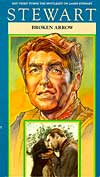 Hollywood would often mix fact with fiction and prejudicial bias in its westerns. Delmer Daves' revisionist western Broken Arrow (1950), however, was considered the first Hollywood picture to seriously take the side of the Indians (Native-Americans) and emphasize peaceful co-existence, with a sympathetic portrayal of Apache chief Cochise (by white actor Jeff Chandler with a Best Supporting Actor nomination - it was his first of three films as the Indian chief), and Debra Paget as Indian maiden Sonseeahray. This film also marked the beginning of James Stewart's post-war work as a western character. [Broken Arrow became a TV series in the mid-50s.] Pony Express (1953) was a quasi-historical account of the extension of the mail route with western legends Buffalo Bill Cody (Charlton Heston) and Wild Bill Hickok (Forrest Tucker). Another Charlton Heston western, titled Arrowhead (1953) expressed a biased view of Indians and starred Jack Palance as an Apache chief. Hollywood would often mix fact with fiction and prejudicial bias in its westerns. Delmer Daves' revisionist western Broken Arrow (1950), however, was considered the first Hollywood picture to seriously take the side of the Indians (Native-Americans) and emphasize peaceful co-existence, with a sympathetic portrayal of Apache chief Cochise (by white actor Jeff Chandler with a Best Supporting Actor nomination - it was his first of three films as the Indian chief), and Debra Paget as Indian maiden Sonseeahray. This film also marked the beginning of James Stewart's post-war work as a western character. [Broken Arrow became a TV series in the mid-50s.] Pony Express (1953) was a quasi-historical account of the extension of the mail route with western legends Buffalo Bill Cody (Charlton Heston) and Wild Bill Hickok (Forrest Tucker). Another Charlton Heston western, titled Arrowhead (1953) expressed a biased view of Indians and starred Jack Palance as an Apache chief.Robert Enrico's Oscar-winning, dialogue-less, 28-minute short La Riviere du Hibou (1962) was a French adaptation based on Ambrose Bierce's 1891 story 'An Occurrence at Owl Creek Bridge'. The Civil War western story with a twist-ending, about an innocent man who seemed to escape from death by a hangman's noose, became well-known when shown to a large American audience as an edited and narrated episode (the final episode!) of Rod Serling's The Twilight Zone television show in 1964. Wide-Screen Westerns: To combat the decline of the film western, wide-screen frontier epics in the 50s and early 60s appeared, emphasizing the western frontier and expansion. Representative films included:
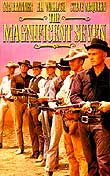 Sturges' Gunfight at the OK Corral (1957) told the story of Marshal Wyatt Earp (Burt Lancaster) in Tombstone, Arizona feuding with the Clantons and their hired guns -- with its inevitable showdown in 1888, aided by the gunfire of rum-soaked Dr. John 'Doc' Holliday (Kirk Douglas). His next popular film, The Magnificent Seven (1960) rewrote a Japanese classic about Samurai warrior-swordsmen that defended a 14th century village (Akira Kurosawa's The Seven Samurai (1954)). This updated 'remake,' featuring a memorable, Oscar-nominated score by Elmer Bernstein, starred these seven gun-slinging American outlaws who defended Mexican peasants against bandit leader Eli Wallach: Sturges' Gunfight at the OK Corral (1957) told the story of Marshal Wyatt Earp (Burt Lancaster) in Tombstone, Arizona feuding with the Clantons and their hired guns -- with its inevitable showdown in 1888, aided by the gunfire of rum-soaked Dr. John 'Doc' Holliday (Kirk Douglas). His next popular film, The Magnificent Seven (1960) rewrote a Japanese classic about Samurai warrior-swordsmen that defended a 14th century village (Akira Kurosawa's The Seven Samurai (1954)). This updated 'remake,' featuring a memorable, Oscar-nominated score by Elmer Bernstein, starred these seven gun-slinging American outlaws who defended Mexican peasants against bandit leader Eli Wallach:
John Wayne: The Archetypal Western Hero (or Anti-Hero) 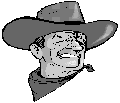 John Wayne, towering and dominant, remains the most popular and durable of the major western film stars of the modern era. [Other western stars also included Henry Fonda, Clint Eastwood, Randolph Scott, James Stewart, Joel McCrea, and Gary Cooper.] In Wayne's many films, he embodied the great American hero and forever closely identified with the genre. A short summary of his films shows how deeply ingrained he was within the western film. John Wayne, towering and dominant, remains the most popular and durable of the major western film stars of the modern era. [Other western stars also included Henry Fonda, Clint Eastwood, Randolph Scott, James Stewart, Joel McCrea, and Gary Cooper.] In Wayne's many films, he embodied the great American hero and forever closely identified with the genre. A short summary of his films shows how deeply ingrained he was within the western film.Nine years after his first western The Big Trail (1930), Wayne further developed his western persona in 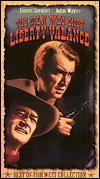 John Ford memorably united two major stars of the genre in his last great film, the excellent adult western The Man Who Shot Liberty Valance (1962), John Wayne and James Stewart -- and also Lee Marvin as 'Liberty Valance' (shot by Stewart). Its byword was "When the Legend Becomes Fact, Print the Legend." In the 60's, Wayne also acted in Andrew McLaglen's comedy western McLintock! (1963) (a battle-of-the-sexes film with Maureen O'Hara), Burt Kennedy's The War Wagon (1967) with Kirk Douglas, and Henry Hathaway's The Sons of Katie Elder (1965) with Wayne's second co-starring role with Dean Martin. John Ford memorably united two major stars of the genre in his last great film, the excellent adult western The Man Who Shot Liberty Valance (1962), John Wayne and James Stewart -- and also Lee Marvin as 'Liberty Valance' (shot by Stewart). Its byword was "When the Legend Becomes Fact, Print the Legend." In the 60's, Wayne also acted in Andrew McLaglen's comedy western McLintock! (1963) (a battle-of-the-sexes film with Maureen O'Hara), Burt Kennedy's The War Wagon (1967) with Kirk Douglas, and Henry Hathaway's The Sons of Katie Elder (1965) with Wayne's second co-starring role with Dean Martin.In later years, Wayne's character aged and matured in such "autumnal" films as Howard Hawks' El Dorado (1967) (a remake of Hawks' ownRio Bravo (1959) again with Wayne), Henry Hathaway's True Grit (1969) in which he finally won a Best Actor Oscar as Rooster Cogburn, a boozy marshal engaged in a track-down, and in its sequel, Rooster Cogburn (1975), with Wayne in an African Queen-like role opposite Katharine Hepburn. Two of Wayne's last-day films were Mark Rydell's The Cowboys (1972) and Don Siegel's elegiac The Shootist (1976), in which Wayne (in his final film) played a famous gunfighter seeking peace while dying of cancer. |